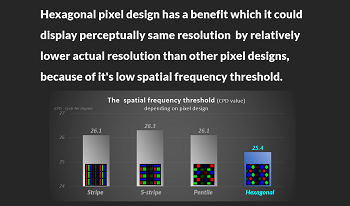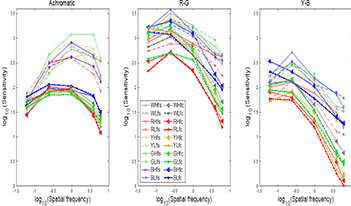
Pixel designs can be made in a variety of ways to produce full color. Designs using stripe, S-stripes, pentiles, and hexagons are frequently employed. In this study, we have conducted perceptual experiments to determine the spatial frequency (CPD) threshold of each pixel design. Based on the 4 kinds of pixel design, we created various stimuli. They are stripe line-patterns that are oriented in five distinct directions (angle: 0, 90, 45, 23, and 62degrees), each with a several CPD (cycle per degrees) and contrast ratio but a similar luminance (about 70 cd/m2). As a result, the spatial frequency threshold of the hexagonal shape is lower than that of other designs in all directions. This implies that hexagonal shapes with comparatively lesser resolution may provide equivalent perceived resolution to other designs. However, there is not big difference between each design. Therefore, more research and study on different patterns or stimuli (such as text, words or images utilized in daily life) are required in the future.

The goals of this work are to accumulate experimental data on contrast sensitivity functions and to establish a visual model that incorporates spatial frequency dependence. In the experimental design, two patterns were compared: fixed-size and fixed-cycle stimuli from different luminance levels. The detection thresholds have been measured for chromatic contrast patterns at different spatial frequencies. The present experiment was conducted with the aim to form a most comprehensive data by combining with our data. The experimental parameters including (1) five colour centres (white, red, yellow, green and blue), which were recommended by the International Commission on Illumination (CIE), at two different luminance levels for each colour centre; (2) three colour directions for each colour centre, namely luminance, red-green and yellow-blue and (3) five spatial frequencies, 0.06, 0.24, 0.96, 3.84 and 6.00 cycles per degree (cpd). The present and our earlier data were combined to form a complete set data to develop and test different models. A 10-bit display characterized by GOG model was used to obtain contrast thresholds of different color centers by the 2-alternative forced choice method and stair-case method. The experimental results revealed different parametric effects and also confirmed the McCann’s finding that the number of cycles affects the comparative sensitivity. Finally, a cone contrast model and a postreceptoral contrast model proposed by Mantiuk et al was developed by fitting the visual test data (fixed number of cycles and fixed size). The models could accurately predict the contrast sensitivity of different color centers, spatial frequencies and stimulus.